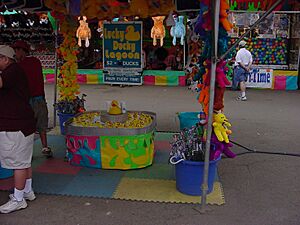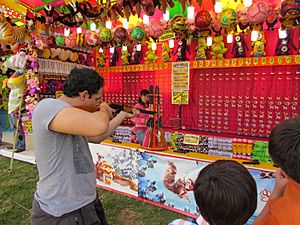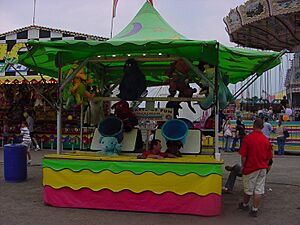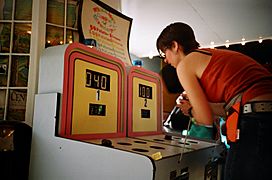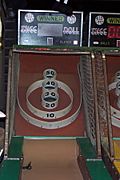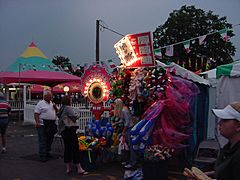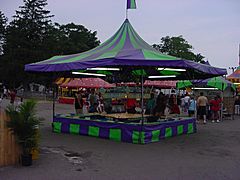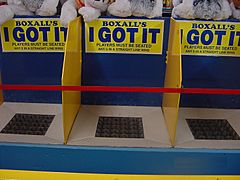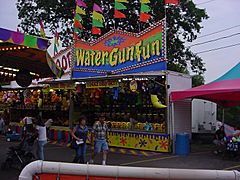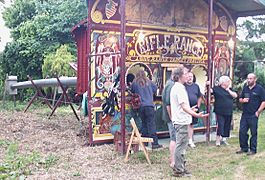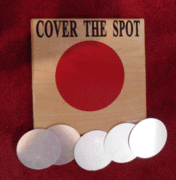Carnival game facts for kids
A carnival game is a fun activity you can play at a traveling carnival, a theme park, or a state or county fair. You might also see them at charity events or arcades. People often play these games during holidays like Mardi Gras or Oktoberfest.
You usually pay a small fee to play a carnival game, maybe from 25 cents to a few dollars. If you win, you often get a small prize like a stuffed animal or a toy. If you keep playing and win more small prizes, you can sometimes trade them in for a bigger prize! Some games, like the "Watergun" game, let many people play at once. The size of the prize might depend on how many players there are. For harder games, like "Baseball and Basket," a big prize might be given to any winner.
Sometimes, carnival games have had a bad reputation. This is because some games might use optical illusions or tricks that make it hard to tell how difficult they really are. In the past, some game operators cheated players. Today, many places have rules, and local police or officials often check games to make sure they are fair.
Contents
Who Runs Carnival Games?
At big amusement parks, the park usually owns and runs the carnival games. These games are often in permanent buildings. But at a traveling carnival, different people might own and operate their own games. These owners make deals with the carnival to bring their games along. Many of these games are built into trailers so they can be easily moved. Some games are still set up from scratch at each new location. You'll usually find all these games lined up along the "midway" area, next to the rides.
Types of Carnival Games to Play
Games of Chance: Try Your Luck!
Games of chance are popular at carnivals because everyone has a random chance to win a prize. One example is the "Dime Pitch" game. Here, you try to toss a coin, like a dime or quarter, onto a board. The goal is to completely cover a marked spot on the board with your coin. If you do, you win!
Another game of chance is the "Birthday" game. Players place bets on a strip that has months, colors, or holidays. Many people bet on their birthday month. Then, a player throws a large, many-sided die into a special area. The die has months, colors, or holidays on its sides. Whatever shows on top when the die stops tells who won.
In the "Pingpong Ball and Fish Bowl" game, you throw pingpong balls into small fish bowls. If your ball lands in a bowl, you often win a goldfish. Games like the "Duck Pond" are great for younger kids. They often let everyone win! You pick a rubber duck floating in water, and a message on the bottom of the duck tells you your prize.
Games of Skill: Test Your Abilities!
Games of skill are another favorite type of carnival game. These games often test how well you can aim. You might throw a ball or use a toy weapon to hit a target. Examples include the "Cross Bow Shoot," the "Milk Bottle" game, or the "Balloon and Dart" game.
Other skill games challenge your physical strength or balance. The "Rope Ladder Climb" is one such game. You have to keep your balance while climbing a rope ladder that can swing and flip you around. The goal is to climb to the top without falling and ring a bell. Another game that tests your strength is "Ring the Bell". You use a big mallet to hit a pad, which sends an indicator up a tall scale. If you hit it hard enough, the indicator rings a bell at the very top, meaning you win! "Cover the Spot" is a game where you try to cover a large red spot with five smaller discs. You drop the discs by hand, and all the red must be covered to win.
Understanding "Rigged" Carnival Games
Carnival games sometimes get a bad reputation for being unfair. This comes from things that happened in the past, but it doesn't always mean games are unfair today.
In the past, some dishonest game operators would try to trick people into playing their unfair games. They might even mark a player's back with chalk so other dishonest operators would know to try and get that person to play their games too.
A game can be made unfair in different ways. For example, in the "Ball and Basket" game, the basket might be set up at an angle that makes it harder for the ball to stay in. Sometimes, the operator might leave a ball in the basket during a demonstration (which helps the ball stay in), but then remove it when you play, making it bounce out easily. In "Ring Toss," the blocks holding the prizes might be shaped so that the ring can't possibly fit over them. The "Balloon and Dart" game can be made harder by not fully inflating the balloons or by using darts with dull tips. Some games can even be switched between fair and unfair by the operator. The "Milk Bottle" game can be like this. On an unfair game, one of the milk bottles might be heavier than the others. How the bottles are stacked can decide if you win or not.
Some games are simply designed to be very difficult, or even impossible, to win. One example is the "Push 'em Up" (or "Stand the Bottle") game. In this game, you try to stand up a bottle using a plastic fork with two prongs. The bottles used in this game are often weighted on one side. This makes it almost impossible to stand them upright without them tipping over when the heavy side rotates to the top. However, another game called "Bottle Up" is different. It's a true skill game where you use a fishing pole with a ring to try and stand up the bottle.
When games are made unfair, the operators can earn a lot more money. Because of this, in many places, local police or officials will check carnival games before and during the event. They do this to help stop unfair games. Even so, a few dishonest operators might still try to cheat. They might make the game fair when it's being tested, but then make it unfair for other players.
Carnival Game Photos
Popular Carnival Games List
- Ball and Bucket Toss
- Balloon And Dart
- Basketball
- Big Six wheel
- Bingo
- Birthday
- Bottle Stand
- Bulldozer
- Cover the spot
- Crazy Bike
- Cross Bow Target Shoot
- Darts
- Duck Pond
- Dunk tank
- Fishing
- High striker or Ring the Bell
- Horse Race
- I Got It
- Kissing booth
- Ladder Climb
- Milk Bottle
- Pingpong Ball and Fishbowl
- Plate Break
- Ring toss
- Shoot the Freak
- Shooting Gallery
- Skee-Ball
- Tin can alley
- Water Gun
- Weight Guessing Booth
- Whac-A-Mole
See also
 In Spanish: Juego de feria para niños
In Spanish: Juego de feria para niños



